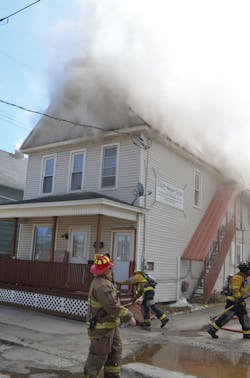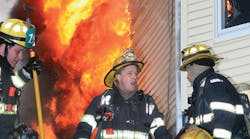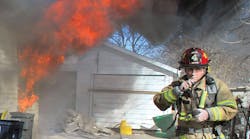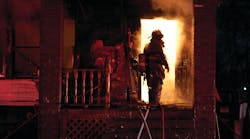Fireground Operations: How to Nail Your First-Due Strategic Responsibility Part 6
Welcome back and thank you for your commitment to the development of a proud history and tradition of aggressive strategy. (You are committed, right?) This article formalizes what has been up to now the initiation of command responsibility.
What does “initiating” mean? In the spirit that words should mean something, with boxes one, two and three the first-due fire officer had one foot in command responsibility and the other foot in team leader (company officer) responsibility. This means the first-due officer was too busy to be anchored to a command post; the officer was free to do a size-up and perhaps assist with non-hazard area firefighter tasks such as preparing the fireground for an offensive transition.
Command duties
When box four is opened, the fire officer will establish a command post, anchor both feet at that command post and address the three responsibilities of command: managing strategy, resources and risks. No more wandering around the incident scene or assisting with task-level firefighter activities. In short, if you are going to call yourself “command,” you will command from a command post, not from a hoseline.
If initially you will share command responsibility with company officer/team leader responsibility, you will retain your company designator: Engine 1, Truck 1, Rescue 1, Squad 1…you get the idea. Words should mean something.
Here’s an important clarification: Should a chief officer arrive at some point during the box one through box three progression, the chief may choose to establish the command post. However, we recommend that the fire officer who completed the size-up (box two) and drafted the initial action plan (box three) retains command responsibility until the higher-ranking officer knows what is going on, including: what and where the problems are, what the plan is to solve those problems, who’s there, what they are doing and where they are working. Finally, all this information should be congruent with the declared operational mode.
The take-away message here is that whoever completes the size-up and drafts the initial action plan should implement that action plan. It makes no sense from a risk-management perspective for the first-due company officer to complete the size-up, draft the initial action plan and then have the chief arrive and establish command. That said, there is a proactive strategic transition that works well:
1. The first-due officer completes size-up and drafts initial action plan. This is per National Fire Protection Association (NFPA) 1021, Fire Officer I.
2. That same officer establishes the command post, perhaps at Engine 1, and begins implementing that initial action plan.
3. The chief arrives, updates the size-up, ensures tactical accountability has been achieved, assumes (transfers) command responsibility and assigns the former incident commander as a division supervisor.
4. The first-due company officer, now the division supervisor, will CONTINUE to implement the initial action plan that was developed based on the size-up performed by that same officer.
5. The chief, who is now the incident commander, will be responsible for everything else except the continued execution of the initial action plan by the first-due officer (now the division supervisor). “Everything else” includes subsequent alarms, staging, addressing problems not being solved by the division supervisor, span of control, assigning an incident safety officer (see Fire Studies on page XX), move-ups to cover fire stations, etc. The strategic evolution complies with NFPA 1021 and NFPA 1561 while ensuring that the command transition is seamless.
Are you really in command?
Here’s a question for all the Incident Command System (ICS) purists out there: If you are responsible for and communicating with Engine 1, are you functioning as the incident commander or a division/group supervisor? (Forget what your colorful vest reads or where your name is on the ICS chart; who you are talking to on the radio reveals your true ICS position.)
Fire officers do not assume command responsibility because of their rank or seniority. Rather, fire officers assume command responsibility because they know what and where the problems are and because they have a plan to solve those problems within the margins of an appropriate operational mode.
Before we get going, we need to address an issue that drives us (and many others) nuts: We must stop the nonsense of somebody called “Command” being engaged in firefighter tasks. When did it become acceptable for the incident commander to operate on a hoseline or assist with other firefighter activities? We’re not just cranky fussbudgets; we are supporting the national consensus. Here is a quick review of the national consensus:
NFPA 1021, Fire Officer I (key citations highlighted)
4.6.1 Develop an initial action plan, given size-up information for an incident and assigned emergency response resources, so that resources are deployed to control the emergency.
4.6.2 Implement an action plan at an emergency operation, given assigned resources, type of incident, and a preliminary plan, so that resources are deployed to mitigate the situation.
Discussion: It should be obvious that the first NFPA 1021 citation (4.6.1) is talking about strategic expectations for the first-due fire officer. It would make no sense for the first on-scene fire officer to “‘fast attack” before a size-up has been completed and an initial action plan developed based on that size-up.
Continuing to the second NFPA 1021 citation (4.6.2), after the first on-scene fire officer has completed a size-up and developed the preliminary (initial) action plan, where should that fire officer be located in order to “implement” the action plan? Advancing a hoseline down a hallway? End of discussion.
Maybe you think it’s acceptable for an incident commander to advance a hoseline and participate in the “fast attack” mode. Fast attack is the complete antithesis of NFPA 1021, Fire Officer I. Still not convinced? Perhaps another national consensus standard will help square some rounded corners:
NFPA 1561 (key citations highlighted)
8.1.8 At an emergency incident, the incident commander shall have the responsibility for the following:
1. Arrive on-scene before assuming command.
2. Assume and confirm command of an incident and take an effective command position.
3. Perform situation evaluation that includes risk assessment.
4. Initiate, maintain, and control incident communications.
5. Develop an overall strategy and an incident action plan and assign companies and members consistent with the standard operating procedures.
6. Initiate an accountability and inventory worksheet.
7. Develop an effective incident organization by managing resources, maintaining an effective span of control, maintaining direct supervision over the entire incident and designating supervisors in charge of specific areas or functions.
8. Review, evaluate and revise the incident action plan as required.
9. Continue, transfer and terminate command.
10. On incidents under the command authority of the fire department, provide for liaison and coordination with all other cooperating agencies. On incidents where other agencies have jurisdiction, implement a plan that designates one incident commander or provides for unified command.
Do you see assisting with task-level firefighter activities listed among the responsibilities of command? Did you notice that citations 3 and 5 align with the previous NFPA 1021, Fire Officer I citations? Advancing a hoseline makes it impossible to address the listed responsibilities of command. Still not convinced and need additional proof? Consider the following federal mandate:
National Incident Management System (NIMS) 100, Unit 4 (key citations highlighted)
The incident commander has overall responsibility for managing the incident by planning strategies, establishing objectives and implementing tactics. These are critical functions and, until delegated, are the responsibility of the incident commander.
The incident commander is “specifically responsible” for:
? Ensuring incident safety.
? Providing information to internal and external stakeholders.
? Establishing and maintaining liaison with other agencies participating in the incident.
Again, do you see anything listed that resembles a task-level firefighter activity? There is a difference between implementing (assigning) tactics and doing tactics; incident managers ASSIGN tactics; firefighter DO the tactics. These citations describe the responsibility of a fire officer who has command-level responsibility As cool and sexy as it sounds to declare “going in with a handline for fast attack,” task-level firefighter activities interfere (and conflict) with the execution of national consensus command responsibilities.
Performance expectations
I guarantee that these national consensus citations were not crafted as background noise to be ignored. They were crafted to provide fire departments with guidance and direction for developing rational policy for establishing fire officer performance expectations.
If you think we are splitting hairs, consider this: A few years ago, a video was circulating that showed an incident commander (the captain of first-due engine) advancing a hoseline into a confirmed building fire. Meanwhile, the officer aboard the second-due engine arrived, observed a safety concern and directed the (task-level) incident commander to withdraw. Did you catch the significance of that sequence of events? (I’ll pause while you read the arrival sequence again.)
Isn’t it supposed to work the other way around? An engine company directing the incident commander to withdraw from the hazard area is evidence that advancing a hoseline within the hazard area is not an “effective command position.” What if there had been an actual safety threat and the second-due engine had been delayed two or three minutes?
You see the same nonsense happen when task-level team leaders are designated as division or group supervisors within the Immediately Dangerous to Life or Health (IDLH) area! (Hey, if Engine 1 is performing a tactical-level company assignment call them “Engine 1.” (Never designate a team by what they are doing or where they are working.)
All of this nonsense has got to stop; it’s time to connect the dots of fire officer responsibility and incident commander responsibility.
Consider a wildland fire; wildland incident managers know how to use the ICS. What are the odds you will see the incident commander participating in a progressive hoselay? What are the odds that you will find a division supervisor or group supervisor digging a fire line? You will encounter engine “bosses” and firefighters participating in task-level activities. It’s called “division of labor.”
This concept conjures two of my “Command Caveats”:
1. Any designation that has a corresponding colorful ICS vest will never function at task level.
2. Any designation that has a corresponding colorful ICS vest will never be positioned within hazard area. ICS positions that have a corresponding colorful vest include: incident commander, command staff, section chiefs, branch directors, division/group supervisors and staging area manager.
It is quite simple: as the first-due fire officer, if you’re going to change your name to “Command,” you must be located at a command position (read: command post), not advancing a hoseline, crawling around in smoke or wandering the fireground with a portable radio. Thus, another “Command Caveat”: Engine companies advance hoselines; incident commanders advance the responsibilities of command.
The reason a fire department responds to a building fire is to plan for and achieve strategically beneficial outcomes, not to provide firefighters with tactical entertainment. It is not an accident that the tone of this article sounds like an industry admonition, but somebody has to be the pebble that hits the pond.
Next: It’s time to connect the dots and square the corners.
THE “FOUR-BOX” PROCESS
BOX ONE
Arrival Radio Report:
1. Type of occupancy and what is showing
2. Designate side Alpha
3. Capture responding units
4. Initiate command responsibility
5. Declare investigation mode
BOX TWO
Aggressive & Focused Strategy:
1. Set the table (get the team going at task level)
2. Find someone to talk to (occupant, security guard, etc.)
3. List the “big six” problems (fire, smoke, verified occupants, possible occupants, exposures and access)
4. Determine value-time-size (V-T-S)
5. Identify hazards
BOX THREE
Size-Up Report:
1. Building snapshot (type of construction, size, number of floors, etc.)
2. “Big six” problem report
3. Update the operational mode (call the play)
4. Draft and implement the initial action plan
5. Achieve tactical accountability (who-what-where)
BOX FOUR
Establish Command Post:
1. Name and locate the command post
2. Capture and control all resources
3. Support and coordinate tactical objectives
4. Maintain tactical accountability
5. Factor the incident clock
FREE STUFF
If you missed some of the first-due articles, visit www.imsalliance.com/ITAC/itac-articles, where you will find all of Mark Emery’s Firehouse® articles. And, as always, if you would like to receive a PDF of our Four Box Quick Reference (not for use in the field), Mark’s Action Plan Template (APT) for a routine building fire, his ITAC Status Board Shorthand reference sheet or his TRIPOD Quick Reference, simply send an email request to Mark Emery at [email protected]. Please include who you are and where you’re from.
MARK EMERY, EFO, a Firehouse® contributing editor, is a fire commissioner with Woodinville Fire and Rescue in King County, WA, from which he retired in 2010 as an operations battalion chief. He also is president of Fire Command LLC and received the 2013 George D. Post Instructor of the Year award. Emery is a graduate of the National Fire Academy’s Executive Fire Officer (EFO) Program, Region X director of the National Fire Academy Alumni Association and Western Region director of the International Association of Fire Service Instructors. He received a bachelor of arts degree from California State University at Long Beach. STEWART ROSE is a fire service instructor who retired from the Seattle, WA, Fire Department as deputy chief and director of training and safety. He also was a shift commander, battalion commander and first-line supervisor of engines, trucks and fireboats. He has served on numerous fire service committees nationally. Part one was in the January 2012 issue, part two was in the March 2012 issue, part three was in the July 2012 issue, part four was in the February 2013 issue and part five was in the September 2013 issue.
Mark Emery/ Stewart Rose
MARK EMERY, EFO, a Firehouse® contributing editor, is a fire commissioner with Woodinville Fire and Rescue in King County, WA, from which he retired in 2010 as an operations battalion chief. He also is president of Fire Command LLC and received the 2013 George D. Post Instructor of the Year award. Emery is a graduate of the National Fire Academy’s Executive Fire Officer (EFO) Program, Region X director of the National Fire Academy Alumni Association and Western Region director of the International Association of Fire Service Instructors. He received a bachelor of arts degree from California State University at Long Beach. STEWART ROSE is a fire service instructor who retired from the Seattle, WA, Fire Department as deputy chief and director of training and safety. He also was a shift commander, battalion commander and first-line supervisor of engines, trucks and fireboats. He has served on numerous fire service committees nationally. Part one was in the January 2012 issue, part two was in the March 2012 issue, part three was in the July 2012 issue, part four was in the February 2013 issue and part five was in the September 2013 issue.










